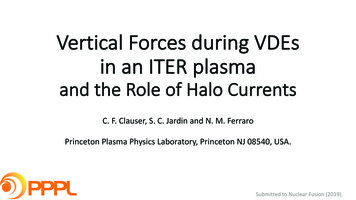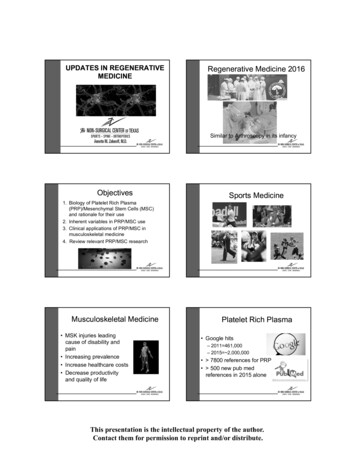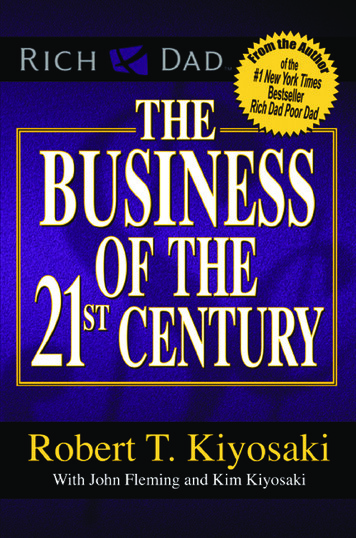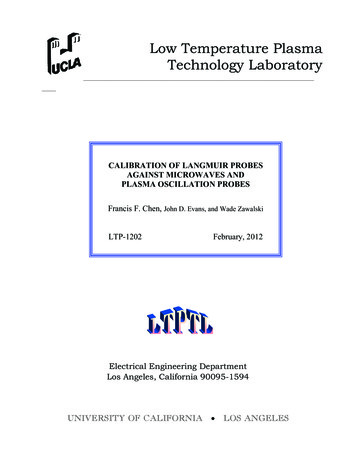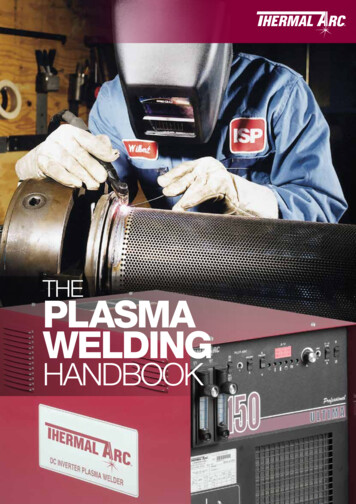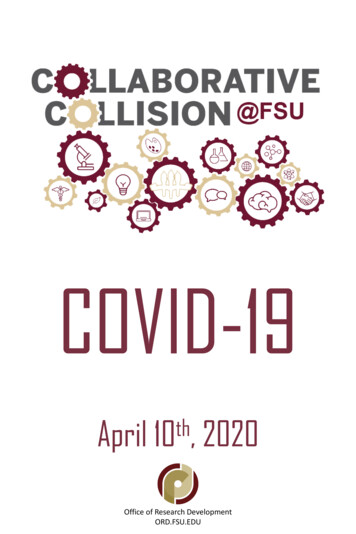Transcription
J Shoulder Elbow Surg (2019) 28, 112–119www.elsevier.com/locate/ymsePlatelet-rich plasma versus Tenex in the treatmentof medial and lateral epicondylitisAllison L. Boden, MD, Michael T. Scott, BS, Poonam P. Dalwadi, BS,Kenneth Mautner, MD, R. Amadeus Mason, MD, Michael B. Gottschalk, MD*Emory University School of Medicine, Atlanta, GA, USABackground: Medial epicondylitis and lateral epicondylitis are among the most common elbow pathologies affecting people aged between 40 and 50 years. Although epicondylitis is often a self-limiting conditionthat improves with conservative treatment, the condition can be difficult to eradicate. The purpose of thisstudy was to compare the effectiveness of platelet-rich plasma (PRP) injections and ultrasound-guided percutaneous tenotomy (Tenex) for the treatment of medial or lateral epicondylitis. Our hypothesis was thatthe Tenex procedure would not be inferior to PRP injections in the treatment of medial or lateral epicondylitis.Methods: In this retrospective review, 62 of 75 patients were available for contact via phone and e-mailto complete post-procedure patient-reported outcome surveys. Subjective assessment of pain and function included a visual analog scale for pain; the Quick Disabilities of the Arm, Shoulder and Handquestionnaire; and the EuroQol-5D questionnaire. The inclusion criteria included age of 18 years or olderand previous failure of nonoperative treatment.Results: The average ages in the PRP and Tenex groups were 47 years and 51 years, respectively. ThePRP cohort (n 32) included 10 female and 22 male patients, whereas the Tenex cohort (n 30) included 12 female and 18 male patients. The PRP and Tenex groups both demonstrated clinical and statisticalimprovement in visual analog scale pain scores; Quick Disabilities of the Arm, Shoulder and Hand scores;and EuroQol-5D scores. No statistically significant difference was found between the 2 treatment modalities.Conclusion: The PRP and Tenex procedures were both successful in producing clinically and statistically significant improvements in pain, function, and quality of life.Level of evidence: Level III; Retrospective Cohort Design; Treatment Study 2018 Journal of Shoulder and Elbow Surgery Board of Trustees. All rights reserved.Keywords: Elbow pain; epicondylitis; platelet-rich plasma; Tenex; tennis elbow; golfer’s elbowEpicondylitis is a common disease that affects the mobility and function of the arm and impairs quality of life. Theprevalence of lateral epicondylitis (LE), known as “tenniselbow,” and medial epicondylitis (ME), known as “golfer’selbow,” often peaks between 40 and 50 years of age, and theThis retrospective review was approved by the institutional review board beforeinitiation of the study (Emory University IRB00091245).*Reprint requests: Michael B. Gottschalk, MD, Emory University Schoolof Medicine, 4555 N Shallowford Road NE, Atlanta, GA 30329, USA.E-mail address: mbgotts@emory.edu (M.B. Gottschalk).2 conditions have very similar pathologies.32 Pain symptoms commonly arise owing to repetitive movements of theforearm and wrist. Although previously posited to be causedby increased inflammation, this condition is now believed tobe tendinosis, comprising degeneration of the tendinous insertion about the elbow in addition to a molecular inflammatoryresponse.1,8,19,23,32 With the aging population and the increasing percentage of this population remaining physically active,the incidence of LE or ME is likely to increase significantlyin the coming years.1058-2746/ - see front matter 2018 Journal of Shoulder and Elbow Surgery Board of Trustees. All rights reserved.https://doi.org/10.1016/j.jse.2018.08.032
PRP versus Tenex for epicondylitisA variety of surgical and nonsurgical methods are available to treat LE or ME.3,17-19,22,32,35 The majority of patientswith LE or ME seek out conservative treatment before turningto surgery. Several studies have reported that these nonsurgical treatments (rest, physical therapy, nonsteroidal antiinflammatories, and bracing) have shown some long-termefficacy whereas corticosteroid injections alone have not demonstrated a long-term effect on pain or function.17,18,35 Ingeneral, there is no consensus on which treatments are themost effective in managing epicondylitis (Table I). Becauseof the lack of consistency regarding treatment success reported in the literature, it is important to investigate newnonsurgical techniques that can be used in the treatment andrecovery of patients with epicondylitis.Platelet-rich plasma (PRP) injections and ultrasoundguided percutaneous tenotomy (Tenex in this study; TenexHealth, Lake Forest, CA, USA) are 2 such treatment methodsthat may prove effective in treating refractory epicondylitis.With PRP injections, blood from the patient is collected andcentrifuged to achieve a very high concentration of platelets; then, the plasma is injected into the damaged area.3,22This injection saturates the damaged tissue withsupraphysiological levels of growth factors to augment andimprove the healing process.24 The minimally invasive Tenexprocedure is performed through a small skin incision and usesultrasonic energy to break down and remove scar tissue inthe damaged region, creating an acute inflammatory reaction and facilitating tendon healing. 13 Alternatively, anadditional method for percutaneous tenotomy can be performed with an ultrasound and an 18-gauge needle wherebythe tendon is fenestrated multiple times. For this study, theproprietary Tenex machine was used. Although results usingPRP and Tenex for the treatment of LE or ME have been promising thus far,2,3,15,22,25,26 it is unclear whether 1 technique ismore effective, and there has never been a direct comparison between the 2 treatment modalities to our knowledge.However, a prior study compared PRP with conventional needling alone (non-Tenex) and demonstrated a late benefit withPRP.25The purpose of this study was to compare the effects ofa single PRP injection versus Tenex on pain and function inthe treatment of LE or ME, as well as to determine whether1 treatment is superior to the other. Our hypothesis was thatthe Tenex procedure would not be inferior to PRP injections in the treatment of ME or LE.Materials and methodsThe inclusion criteria included (1) a trial of conservative therapyas defined by a subjective failure of physical therapy for at least 3months; (2) patients with a clinical diagnosis of LE or ME who underwent any type of PRP or Tenex procedure at a single institutionfrom September 1, 2014, to May 1, 2017; and (3) patients aged 18years or older. The exclusion criteria included (1) patients youngerthan 18 years or older than 80 years and (2) vulnerable subjects (pregnant patients, prisoners, and so on).113Treatment modality decisionInformation on both PRP and Tenex was provided to patients withchronic ME or LE with refractory pain in whom relief with otherconservative measures had been previously attempted. Patient preference and the patient’s prior experience, insurance coverage, andout-of-pocket expense were the main drivers in deciding which treatment modality was chosen. Specifically, PRP is not conventionallycovered under insurance, whereas the Tenex procedure is coveredby most insurance groups. As such, it is possible that patients witha lower socioeconomic status or aversion to spending money outsideof their insurance plan may have been biased to the Tenex group.In addition, most patients had previously undergone advanced imagingwith magnetic resonance imaging and/or ultrasound. In some instances in which there was overt tearing of the tendon as definedby a musculoskeletal radiologist, patients were more likely to betriaged to the Tenex group, given the ability to “débride” the tear.After the patient was presented with the risks, benefits, and alternative procedures and decided on a treatment modality, informedconsent was obtained.PRP procedure protocolAfter the patient was prepared for a blood draw, approximately 30mL of whole blood was harvested from the antecubital fossa of thearm. The blood was processed on site using the Emcyte PurePRPII concentrating system and centrifuge (Emcyte, Fort Myers, FL,USA). The blood was spun in 2 cycles, 1.5 minutes and 5.0 minutes,at 3800 revolutions/min. Approximately 3 mL of leukocyte-poor (LP)and red blood cell–poor PRP was produced. On completion of theblood-processing component of the procedure, the plasma coagulate concentrate was taken directly into the patient’s room. The patientwas then positioned supine on the table and re-prepared in a sterilefashion. A minimal amount of local anesthetic, ropivacaine 0.2%,was either added to the PRP mixture or injected locally as necessary. The plasma coagulate was then infused at the site of pathologyusing ultrasound guidance. After the procedure was completed, thepatient remained supine for 10 minutes and was given postprocedure instructions and protocols (Table II).Tenex procedure protocolThe patient was placed in the supine position, and the affected limbwas then prepared and draped in a sterile fashion. A sterile sleevewas placed over the ultrasound transducer, and a diagnostic ultrasound was performed to identify the anatomy and visualize thepathologic tissue.The area was again prepared with an antimicrobial solution andinjected with 1% lidocaine using a 23-gauge needle. By use of aNo. 11 blade, a tract was made to facilitate the entry of the TXMicroTip (Tenex Health) into the pathologic tissue. The blade continued through the subcutaneous tissue, incising the fascia and tendondown to the site of the pathologic tissue. Next, the TX MicroTiphandpiece was introduced under ultrasound guidance. Once the tipof the instrument was confirmed to be at the site of pathology, thefoot pedal was depressed and the diseased portion of the tissue wasdébrided. Up to 3 minutes of ultrasonic energy was delivered basedon the amount of débridement necessary. After the procedure, SteriStrips (3M Healthcare, St Paul, MN, USA) were placed over theincision, followed by Tegaderm dressing (3M Healthcare) application.
114Table IA.L. Boden et al.Literature review of epicondylitis treatment optionsTreatmentStudies and conclusionsCorticosteroidinjectionAssendelft et al4 (1996) performed a systematic review that identified 12 RCTs. Pooled data showed short-term effectivenessbut no difference at long-term follow-up. Conclusion: Existing evidence on corticosteroid use in epicondylitis isinconclusive.Barr et al5 (2009) performed a systematic review that identified 5 RCTs. Large effect sizes were demonstrated in favor ofcorticosteroid use in the short-term follow-up period. At intermediate- and long-term follow-up, physiotherapeuticinterventions were more effective than steroids. Conclusion: Steroids are effective in the short term, and physiotherapy iseffective in the intermediate and long term.Olaussen et al27 (2013) performed a systematic review that identified 11 RCTs. Corticosteroids had a significant effect onreduction of pain in the short term versus no intervention or NSAIDs. At intermediate-term follow-up, there was anincrease in pain, reduction in grip strength, and negative effect on overall improvement. Conclusion: Steroid injectionshave a positive effect on lateral epicondylitis in the short term but a negative effect in the intermediate term.Smidt et al34 (2002) performed a systematic review that identified 13 RCTs. Statistically significant and clinically relevantdifferences were found regarding pain, global improvement, and grip strength for corticosteroids compared with placebo inthe short term ( 6 weeks), but no difference was found in the intermediate and long term. Conclusion: It is not possible todraw firm conclusions on the effectiveness of corticosteroids because of the lack of high-quality studies.Sims et al33 (2014) performed a systematic review that identified 58 RCTs. It was shown that corticosteroids may have someshort-term benefit, but there is no long-term pain relief. Other noninvasive treatments did not appear to be effective inimproving pain. Conclusion: There is not a preferred method of nonsurgical treatment for this condition. Epicondylitisusually is self-limited and resolves within 12-18 months with no treatment.Smidt et al35 (2002) performed an RCT with 185 participants who either received corticosteroid injections, underwentphysiotherapy, or underwent a wait-and-see policy. At 6 weeks, patients in the injection group reported more painimprovement; however, by 1 year, the physiotherapy group and wait-and-see group showed the most improvement.Conclusion: In the long term, physiotherapy and a wait-and-see policy are better options for treating epicondylitis thancorticosteroids.Bisset et al7 (2006) performed an RCT with 198 participants who received 8 sessions of physiotherapy, underwentcorticosteroid injections, or underwent a wait-and-see policy. Corticosteroid injections showed significantly better effectsat 6 weeks but with high recurrence rates and significantly poorer outcomes in the long term compared withphysiotherapy. Patients who received physiotherapy sought less additional treatment than those in the other 2 groups.Conclusion: Physiotherapy is superior to a wait-and-see policy in the short term and corticosteroid injections in the longterm.Olaussen et al27 (2013) performed a systematic review that identified 11 RCTs. Manipulation and exercise versus nointervention showed a beneficial effect at short-term follow-up. Moderate evidence was found for a benefit with eccentricexercise and stretching versus no intervention at short- and long-term follow-up. Conclusion: Manipulation and/or exerciseand exercise and/or stretching are effective in the short term and long term, respectively.Grewal et al12 (2009) performed a study of 36 patients who underwent arthroscopic release of the extensor carpi radialisbrevis for epicondylitis. Of the 36 patients, 30 reported improvement in pain, strength, motion, and function with surgery.Patients in physically demanding or repetitive occupations and those with workers’ compensation claims had significantlyworse outcomes. Conclusion: Arthroscopic release for epicondylitis provides symptomatic improvement in most patients;patient selection has an important role in outcomes.Owens et al28 (2001) performed a study of 16 patients who underwent arthroscopic release of the extensor carpi radialisbrevis. All patients reported pain improvement at an average follow-up of 24.1 months. Conclusion: Arthroscopic releaseeffectively treats lateral epicondylitis.Arirachakaran et al3 (2016) performed a systematic review of 10 RCTs. PRP injection significantly improved pain and functionwhen compared with corticosteroid injection and autologous blood injection and had a lower complication risk. Conclusion:PRP can improve pain in the treatment of epicondylitis.Krogh et al17 (2013) performed a systematic review of 17 RCTs on injection therapies in the treatment of lateral epicondylitis.Both PRP trials found that PRP was statistically superior to placebo. Conclusion: There is a paucity of evidence fromunbiased trials.Palacio et al29 (2016) performed a study of 60 patients who were randomized to receive either PRP, 0.5% neocaine, ordexamethasone injections. Patient outcomes were assessed using DASH and PRTEE scores. Symptom improvement occurredin 81.7% of all patients. Conclusion: There is no statistically significant difference between the treatments.Peerbooms et al30 (2010) performed a study of 100 patients who were randomly assigned to PRP or corticosteroid injectionsfor the treatment of lateral epicondylitis. The outcomes measured were VAS and DASH scores. Conclusion: Treatment withPRP significantly reduces pain and improves function as compared with corticosteroid injections.Rodik and McDermott31 (2016) performed a review of 3 RCTs and 1 cohort study. All studies demonstrated significantimprovements with PRP over comparison injections or no injections. Conclusion: PRP injections provide more favorablepain and function outcomes than whole blood and corticosteroid injections for 1-2 years after injection.Wait andseePhysicaltherapySurgeryPRPinjectionRCT, randomized controlled trial; NSAIDs, nonsteroidal anti-inflammatory drugs; PRP, platelet-rich plasma; DASH, Disabilities of the Arm, Shoulder andHand; PRTEE, Patient-Rated Tennis Elbow Evaluation; VAS, visual analog scale.
PRP versus Tenex for epicondylitisTable II115Post-procedure protocolPhaseLengthof timeRestrictionsRehabilitationPhase I: tissueprotection0-3 dRelative restActivities as tolerated; avoid excess loading or stress to treated areasGentle movement of extremity (active range of motion)Phase II: earlytissue healing4-14 dConsider using sling forcomfortNo weight trainingAvoid NSAIDs and iceProgress to full weightbearing withoutprotective deviceAvoids NSAIDs and iceAvoid eccentric exercisesAvoid NSAIDs and ice2-6 weeksPhase III:collagenstrengthening6-12 weeks 3 moReassess improvement: ifnot 75% improved,consider repeat injectionand return to phase ILight activities to provide motion to tendonGentle prolonged stretchingMay work on core strengthening and strengthening away from injury siteLow-weight, high-repetition exercise with pain rating 3 of 10Soft-tissue work on tendon, such as deep tissue massage“Dynamic” stretchingEccentric exercises with pain rating 3 of 10Plyometrics; proprioceptive training and other sport-specific exercisesProgress load-bearing activities and consider return to sport if painrating 3 of 10Progress back to functional sport-specific activities with increasing loadon tendon as pain allowsNSAIDs, nonsteroidal anti-inflammatory drugs.Post-procedure protocolStatistical analysisThe post-procedure protocol for PRP and Tenex patients was in accordance with the protocol published by Mautner et al21 in 2011(Table II).A department-designated statistician performed the analysis of thecollected data. Repeated-measures analyses were used to analyzethe QDASH scores, VAS pain scores, and quality-of-life scores usinga means model via the SAS MIXED Procedure (version 9.4; SASInstitute, Cary, NC, USA), providing separate estimates of the meansby treatment group and time in the study (baseline and after procedure). A compound-symmetrical variance-covariance form inrepeated measurements was assumed for each outcome, and robustestimates of the standard errors of parameters were used to performstatistical tests and construct 95% confidence intervals.9 Modelbased means are unbiased with unbalanced and missing data, as longas the missing data are noninformative (missing at random). Predictors included in each model were treatment group, follow-up time,and the interaction between treatment group and follow-up time. Allspecific statistical tests were performed within the framework of themixed-effects linear model, using t tests to compare differencesbetween the model-based means. The results were summarized withadjusted means and 95% confidence intervals by treatment groupand follow-up time. Statistical tests were 2-sided and unadjusted formultiple comparisons. P .05 was considered statistically significant. Before study initiation, sample size calculations performedfor a paired t test using an α of .05, a β of .20, and an effect size of0.50 revealed that cohorts of 30 patients were needed for each treatment group to discern a difference in VAS score. In addition, a simplematched-pair t test was performed for available applicable data.Data collectionAt our institution, patients are contacted to complete patientreported outcome surveys as standard of care both before theprocedure and at various follow-up times. The 75 individuals whomet the inclusion criteria, regardless of whether they had previously completed outcome surveys, were contacted via phone or e-mailto complete post-procedure patient-reported outcome surveys at theinitiation of the study. Data collection included age, sex, affectedjoint, date of the procedure, interventions before and after the procedure, satisfaction with the procedure, and data from patientreported questionnaires before and after treatment. In addition, aretrospective chart review was performed to determine the lengthof pain before the procedure and confirm information collected bythe survey, including sex, affected joint, date of the procedure, andinterventions before and after the procedure.Subjective assessment of pain and function was obtained beforeand after the procedure using a visual analog scale (VAS) for pain;the Quick Disabilities of the Arm, Shoulder and Hand (QDASH)questionnaire; and the EuroQol-5D (EQ5D) questionnaire. Patientbaseline scores were recorded immediately before the procedure.Post-procedure scores were obtained routinely via e-mail voluntarily at 3 months and 6 months after the procedure. In this case wecontacted patients to complete a current survey owing to missingdata after the procedure. Before analysis, the patients were split into2 cohorts: those who received PRP (cohort 1) and those who received the Tenex procedure (cohort 2).ResultsOf the 75 patients who met the inclusion criteria, 62 completed the post-procedure patient-reported outcome surveys
116Table IIIA.L. Boden et al.Descriptive statistics by treatmentCharacteristicsPRP (n 32)Tenex (n 30)P valueAge, yrLength of pain, moFollow-up, RightLeftLateralMedial47 12 (18-73), n 3226 24 (3-98), n 3117 11 (1-34), n 323.8 1.5 (0.0-5.0), n 2951 8 (39-69), n 3025 21 (2-75), n 2910 6 (2-27), n 303.6 1.4 (0.0-5.0), n 30.11*.80*.0020*.68*10/32 (31.3%)22/32 (68.8%)12/30 (40.0%)18/30 (60.0%).47†1/29 (3.4%)3/29 (10.3%)2/29 (6.9%)2/29 (6.9%)9/29 (31.0%)12/29 (41.4%)1/30 (3.3%)2/30 (6.7%)3/30 (10.0%)6/30 (20.0%)8/30 (26.7%)10/30 (33.3%).80†22/32 (68.8%)10/32 (31.3%)26/31 (83.9%)5/31 (16.1%)17/30 (56.7%)13/30 (43.3%)25/30 (83.3%)5/30 (16.7%).33†.99†PRP, platelet-rich plasma.Data are presented as mean standard deviation (minimum-maximum) or as frequency/total (percentage).* Two-sided 2-sample equal variance t test.†Fisher exact test.(83% follow-up rate). The 62 patients included in the analysis were divided into 2 groups based on treatment: 32underwent PRP procedures, and 30 underwent Tenex procedures. No statistically significant difference in average age,sex, affected elbow, length of elbow pain before the procedure, or type of epicondylitis was found between the PRP andTenex groups. The mean follow-up length in the PRP groupand Tenex group (17 months and 10 months, respectively)varied significantly (P .002). There was no statistically significant difference in patient satisfaction between groups, as79.3% of PRP patients and 80% of Tenex patients reportedbeing satisfied with the procedure (Table III). All patients hadpreviously tried activity modification, physical therapy,massage therapy, or corticosteroid injections—or a combination thereof—and the use of all of these conservativetreatments was statistically equivalent between the PRP andTenex groups (Table IV). In 5 PRP patients (16%) and 6 Tenexpatients (20%), additional procedures were performed for theirME or LE because of refractory pain. Of these 11 patients,only 1 in the Tenex group and none in the PRP group underwent surgical intervention.Overall, QDASH scores improved from baseline in boththe PRP and Tenex treatment groups. The QDASH score decreased from 30.0 3.4 to 9.4 3.3 (P .0001) in the PRPgroup and from 35.9 5.0 to 12.5 3.4 in the Tenex group(P .0001). No statistically significant difference in improvement was found between groups: 20.6 for PRP and 23.4 forTenex (P .68).Both treatment groups demonstrated significant improvement in VAS pain scores. The VAS score decreased from4.2 0.5 to 2.3 0.5 (P .0051) in the PRP group and from5.5 0.8 to 2.2 0.5 (P .0005) in the Tenex group. No difference in pain improvement was noted between groups(P .17). In addition, matched pairs were compared withinTable IVTreatment before PRP or Tenex procedurePre-proceduretreatmentPRP (n 32)Tenex (n 30) P value*ActivitymodificationPhysical therapyYesNoMassage nexYesNo32/32 (100.0%) 30/30 (100%)27/32 (84.4%)5/32 (15.6%)27/30 (90.0%) .713/30 (10.0%)4/32 (12.5%)28/32 (87.5%)5/30 (16.7%) .7325/30 (83.3%)17/32 (53.1%)15/32 (46.9%)15/30 (50.0%) .9915/30 (50.0%)4/32 (12.5%)28/32 (87.5%)6/30 (20.0%) .5024/30 (80.0%)1/32 (3.1%)31/32 (96.9%)1/30 (3.33%) .9929/30 (96.7%)PRP, platelet-rich plasma.Data are presented as frequency/total (percentage).* Fisher exact test.
PRP versus Tenex for epicondylitispairs and among pairs between cohorts. PRP demonstrateda mean difference of 1.84, whereas Tenex showed a difference of 3.55. No statistically significant difference was notedbetween cohorts (P .47). However, between pairs in eachcohort, a statistically significant difference was noted(P .0001).The EQ5D scores also improved after PRP or Tenex treatment. The EQ5D score increased from 0.73 0.03 to0.93 0.03 in the PRP group (P .0001) and from 0.65 0.04to 0.89 0.03 in the Tenex group (P .0001). No difference in improvement was found between groups (P .55).DiscussionME and LE are common conditions that affect between 1%and 3% of the population, mainly in persons aged 35 to 55years.2,32 Fortunately, these are self-limiting conditions in themajority of patients.2 Although a multitude of treatment optionsare available, there is currently no clear gold-standard treatment for patients with chronic pain. With the aging population,successful, less invasive treatment modalities are essential.The purpose of this study was to compare 2 treatment options,PRP and Tenex, for the treatment of epicondylitis.Our results showed significant improvements in pain, function, and quality of life in patients in both the PRP and Tenextreatment groups. In addition to the statistically significantimprovement noted in patients, there was a clinically significant improvement. The minimal clinically important differencehas been reported to be between 14 and 16 points on a 100point scale for the QDASH score, 1.2 points on a 10-pointscale for the VAS score, and between 0.04 and 0.08 for theEQ5D score.11,14,16,20,36 The QDASH score improved by 20.6points in the PRP group and 23.4 points in the Tenex group;the VAS score improved by 1.9 points and 3.3 points, respectively; and the EQ5D score improved by 0.20 and 0.24,respectively. All of these changes are well above the citedminimal clinically important difference values and illustratethe clinical improvements made in these patients.Despite myriad studies evaluating the efficacy of PRP, thereis little consensus about its use in the treatment of LE owingto the various methods of preparation and the lack of standardization of the technique. In our study, LP PRP was usedover leukocyte-rich (LR) PRP. It is our belief that this reducesthe risk of a proinflammatory response after injection. Controversy remains as to the implications of LR versus LP PRP.Yerlikaya et al39 performed a double-blinded randomized controlled trial (RCT) of LR versus LP PRP and demonstratedno statistically significant difference for either group compared with a control group receiving saline solution in termsof pain or function. However, the study’s endpoints were at4 and 8 weeks, which may have failed to account for a timedependent treatment. In our study, the PRP cohort had a7-month longer follow-up, which may have skewed some ofthe results. In a study comparing LP PRP with bupivacaine,Behera et al6 demonstrated a time-dependent benefit with the117use of LP PRP regarding pain scores and patient-reported outcomes at 6 months and 1 year compared with a control group.A meta-analysis by Fitzpatrick et al10 evaluated different PRPpreparation methods and injection techniques and found thatLR PRP methods had a stronger positive effect than LP PRP.Other studies have looked at more conventional methodswith adjuvant therapy, such as including PRP. Mishra et al25performed a double-blind, prospective, multicenter RCT of230 patients who underwent ultrasound-guided percutaneous tenotomy with or without LR PRP. The study demonstrateda significant benefit in favor of the LR PRP group regardingpain and satisfaction at 24 weeks’ follow-up. However, thestudy failed to demonstrate a difference at 12 weeks, showingthat PRP may have a time-dependent response. Because patients were not followed up longer, it is unclear whether the2 cohorts reach an equilibrium of response as time from treatment ensues.Regarding more generalized data compared with conventional therapies, many studies have investigated PRP injectionsand Tenex and compared 1 method or the other with bracing,a wait-and-see policy, corticosteroid injections, lidocaine injections, saline solution injections, autologous whole bloodinjections, and arthroscopic and open releases.2,3,17,18,22,35,38 Aliterature review conducted in 2015 by Murray et al26 identified 6 RCTs comparing PRP with other treatment optionsand concluded that although PRP could be a safer and morecost-effective alternative to surgery, results throughout the literature were conflicting and, thus, more research was needed.Of the 6 RCTs, 4 showed that PRP provided a statisticallysignificant improvement in pain compared with active control,corticosteroids, and autologous whole blood injections.26 AnRCT performed in 2017 concluded that PRP significantlyreduces pain and increases function compared with corticosteroids at 6 months.37 Tenex use in patients with recalcitrantLE has been shown to significantly improve VAS and Disabilities of the Arm, Shoulder and Hand scores in as little as1 week and for as long as 12 months, with favorablesonographic tendon changes noted at 6 months.15The strengths of our study include (1) the high followup rate, (2) the large number of patients, and (3) the len
Background: Medial epicondylitis and lateral epicondylitis are among the most common elbow patholo-gies affecting people aged between 40 and 50 years.Although epicondylitis is often a self-limiting condition that improves with conservative treatment, the condition can be difficult to eradicate. The purpose of this
